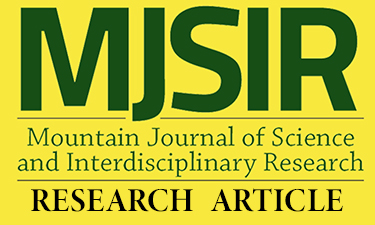Ang Paggamit ng Wikang Filipino sa Pagtuturo sa Larang ng Agrikultura
Main Article Content
Abstract
Mahalaga ang papel na ginagampanan ng wika sa proseso ng pagkatuto, nakasalalay dito ang lubusang pag-unawa sa mga paksang tinatalakay. Nilalayon ng pag-aaral na alamin ang gamit ng wikang Filipino sa pagtuturo sa larang ng agrikultura. Ginamit sa pag-aaral ang disenyong basic qualitative at discourse analysis. Ang discourse analysis ay nagamit upang masuri ang paggamit ng wikang Filipino sa talakayan sa klase. Sa pagsusuri sa pahayag ng mga guro, lumabas na ang wikang Filipino ay ginagamit bilang estratehiyang pangkomunikasyon, wikang pantulong at panlinaw sa mga katawagang teknikal. Ang persepsyon naman ng mga guro sa paggamit ng wikang Filipino ay lumabas ang mga tema na madaling maintindihan ang paksa, madaling ipahayag ang ideya, mas masigla ang interaksyon at mas malalim ang mga ideyang ibinabahagi. Ayon naman sa mga mag-aaral ay mas madaling maintindihan ang mga katawagang teknikal, malayang naipapahayag at naibabahagi ang mga ideya at mas madaling naipapaliwanag ng mga guro ang paksa. Sa kabuuan, naipakita sa pag-aaral na nagagamit ang wikang Filipino sa mga talakayan sa agrikultura; may pagkakahawig ang persepsyon ng guro at mag-aaral; at kapwa sila naniniwala na nakatutulong ang wikang Filipino sa kanilang talakayan. Iminumungkahi ang pagpapatuloy sa paggamit ng wikang Filipino sa mga talakayan at magkaroon ng sariling pagsasanay ang mga mag-aaral sa paggamit ng wika upang mas mabisa at mahusay ang paggamit nito sa talakayan.
(Language plays an important role in the learning process, the thorough understanding of the topic discussed depends on the language. This paper aims to know the use of Filipino language in teaching agriculture subjects. Basic qualitative design and discourse analysis was used in the study. Based on the responses, the following themes were derived; Filipino language is used to expand the discussion and is used to clarify technical terms. The perception of teachers on the use of Filipino language brought out the following themes; the students easily understand the topic, they can easily share their ideas, active interaction, and students can share deep thoughts about the topic. While students believed that using the Filipino language makes them easily understand technical terms, they are free to express and share their ideas and they believed that it is easy for the teachers to explain the topic. The study shows that Filipino language is used in discussions in agriculture subjects; there is a similarity with regards to the perception of the teachers and students, and both agree that Filipino language helps in their discussions. It is recommended that the use of Filipino language in discussion be continued, and students may have self-training in using the language for effective and better use of this in and during discussions.)
Article Details
References
Aquino, F., Callang, C., Bas, H., & Capili, C. (2001). Sining ng Komunikasyon. Kadena Press, Inc. Queszon City, Philippines.
Badayos, P. (1999). Metodolohiya sa Pagtuturo ng Wika, Mga Teorya, Simulain at Istratehiya. Grandwater Publications and Research Corporation. Makati City. ISBN 971–725-050–2.
Bhandari, P. (2020). What is Qualitative Research? Methods and Examples. Scribbr. https://www. scribbr.com/methodology/qualitative-research/
Battle, J., & Lewis, M. (2002). The Increasing Significance of Class: The Relative Effects of Race and Socioeconomic Status on Academic Achievement. Journal of Poverty, 6(2), 21-35. https://doi.org/10.1300/J134v06n02_02
Benson, C. (2005). The Importance of Mother Tongue Schooling for Education Quality: Universal Education, Science and Culture Organization. Commissioned study for EFA Global Monitoring Report 2005.
Broadway, M.S.D., & Zamora, N.C.L. (2018). Ang Filipino Bilang Wika sa Matematika: Isang Palarawang Pagsusuri sa Kaso ng isang Pribadong Paaralan. The Normal Lights, 12(1), 67-99. https://po.pnuresearchportal.org/ejournal/index.php/normallights/article/view/761
Constantino, R. (2015). Intelektuwaslismo at Wika. Daluyan Journal ng Wikang Filipino, 1, 8-12. https://journals.upd.edu.ph/index.php/djwf/article/view/4939
Course Hero. (2019). Filipino Bilang Larangan at sa Iba't Ibang Larangan. University of Santo Tomas. Lecture Note. https://www.coursehero.com/file/p1g1ntsp/ang-mga-batas-natin-ay-nakalimbagsa-Filipino-mga-mambabatas-pangulo-at-mga/
Deocampo, M.F. (2011). The Constraints and Social Functions Influencing Language Switching: A Study of Television Shows in the Philippines. The New English Teacher: An International Journal, 5(2), 56-88. https://repository.au.edu/items/89b7f7e7-c34b-4d18-8622-481ed2ae24f3
Demeterio, F. (2009). Ang Mga Teorya ng Relatividad ni Albert Einsteinn: Isang Pagsusuri sa Kahandaan ng Wikang Filipino sa Pagtalakay sa mga Paksa ng Makabagong Agham. Malay, 21(2), 71-89. https://www.researchgate.net/publication/247905009_Ang_mga_Teorya_ng_Relatividad_ni_Albert_Einstein_Isang_Pagsusuri_sa_Kahandaan_ng_Wikang_Filipino_sa_Pagtalakay_sa_mga_Paksa_ng_Makabagong_ Agham
Demeterio, F. (2013). Ang Paglubog nina Hippokrates at Galen sa Kaunlaran: Isang Interpretasyon sa Anyo ng Siyentipikong Rebolusyon sa Larangan ng Medisina. Kritike: An Online Journal of Philosophy, 7(1), 47-68. https://doi.org/10.25138/7.1.A.4
Fillmore, L., & Snow, C. (2000). What Teachers Need to Know About Language. Clearinghouse on Languages and Linguistics: Special Report. https://www.ventrislearning.com/wp-content/uploads/Wong_Fillmore-2000.pdf
Fajilan, W., & Zafra, R.B. (2015). Ang Paggamit at Kahalagahan ng Wikang Filipino sa Pagtuturo ng Agham: Panayam kay Prop. Fortunato Sevilla III. Hasaan Journal, 2, 116-122. https://hasaan.ust.edu.ph/wp-content/uploads/2019/04/HASAAN-Journal-Tomo-II-2015-116-123-2-8.pdf
Gorgonio, J.P.R. (2012). Use of Filipino and English in Social Studies Learning. University of San Carlos Graduate Journal, 24. https://www.researchgate.net/publication/317231828_USE_OF_FILIPINO_AND_ENGLISH_IN_SOCIAL_STUDIES_LEARNING
Gannaban, M. (2012). Kahusayang Pampagtuturo ng Guro. Dalumat Ejournal, 3(1), 15-28. https://www.researchgate.net/publication/318528545_Isang_Pagsusuri_sa_Persepsyon_sa_at_Aktwal_na_Kahusayang_Pampagtuturo_ng_Guro
Lou, A. (2019). Critical Discourse Analysis Definition, Guide & Examples. Scribbr. https://www.scribbr.com/methodology/discourseanalysis/
Mendillo Jr., B. (2016). Sa pagbanggit ni Ong, G. March 2, 2016. Teaching Various Courses Using Filipino Pushed. The Philippine Star.
Pagkalinawan, L. (2015). Ang Gamit ng Filipino sa mga Talakayan sa Klasrum sa University of Hawaii. Malay, 28(1), 52-66. https://ejournals.ph/article.php?id=8089
Salazar, C. (1996). Ang Filipino sa Inhinyeriya. Malay, 13(1), 122-126. https://ejournals.ph/article.php?id=7831
Tullao, T.S. Jr. (2009). Ekonomiks sa Diwang Filipino: Halo-Halo, Tingitingi at Sari-sari. Malay, 22(1), 101-112. https://ejournals.ph/article.php?id=7961
Vega, S. (2010). Ang Patakarang Pangwika sa Pilipinas At mga Pag-aaral Kaugnay Nito. Elcomblus. https://www.elcomblus.com/ang-patakarang-pangwika-sa-pilipinas/
Vizconde, C. (2006). Attitudes of Student Teachers towards the use of English as Language of Instruction for Science and Mathematics in the Philippines. The Linguistics Journal, 1(3), 7-33. https://www.researchgate.net/profile/ Raphiq-Ibrahim/publication/238523130_Do_languages_with_cognate_relationships_have_advantages_in_second_language_acquisition/ links/02e7e530b2e54e9530000000/Dolanguages-with-cognate-relationships-haveadvantages-in-second-language-acquisition. pdf#page=7

